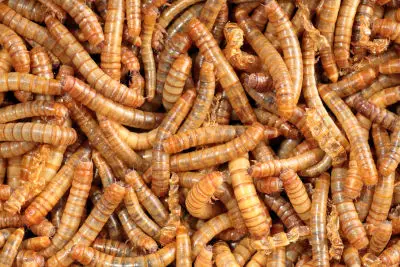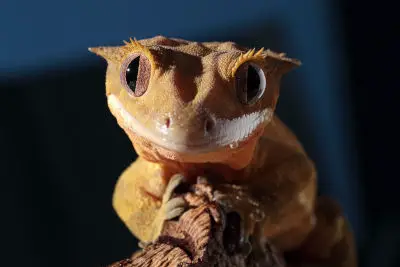What Reptiles Can Be Kept At Room Temp? (Save Money?)
If you are looking for a simple reptile as a pet and ideally without a complicated setup you may be wondering which ones can survive at room temperature…
What reptiles can be kept at room temp?
Several reptiles can be kept at room temperatures. The most common one is a Crested Gecko. But, Cave Geckos and Pygmy Chameleons are known to do OK at room temperature as well. The crested Gecko is quite common because they make good pets as well.
| Are these foods dangerous for your Beardie? | |
| Avacado? Click here to learn, from this guide, if this food is dangerous |  |
| Superworms? Click here to learn, from this guide, if this food is dangerous |  |
So, now that you know. But, do any of these come in different colors? Which ones are also easy to maintain? Are these basking lights and light sources expensive? Keep reading for these answers, and much more…
Do any room temperature reptiles come in different colors?

A crested Gecko on a branch.
Crested Geckos can survive at room temperature and are available in various colors. These color variations are often known as morphs. As well as this they are known to friendly and easy to handle.
This makes the Crested Gecko the ideal choice for someone that wants to save some money on their setup and have a friendly pet for their family.
Are basking lights and light sources expensive?
Basking lights and heat sources are known to quite expensive. And, for some lizards, this is mandatory for them to survive. But, one of the biggest costs that is often overlooked is the running costs. Meaning, the electricity to power the equipment.
The thing about these running costs it is ongoing. Hence the reason why some owners may choose to find a reptile that can survive at room temperature to save these costs.
What is the easiest reptile to keep?
Several reptiles are quite easy to keep such as Bearded Dragons, Leopard Geckos, Tortoises, or even corn snakes. This is one of the reasons why Bearded Dragons and Leopard Geckos are some of the more popular choices.
However, you will still need heating equipment for these lizards, so that will need to be factored into the final decision.
What reptiles are low maintenance?
Reptiles that are low maintenance include Bearded Dragons, Ball pythons, Green Anoles, Leopard Geckos. These make life easier when choosing a pet. But, they do need some investment up-front, and ongoing to maintain them though.
Which type of lizards needs a heat lamp?
While a majority of lizards prefer humid and tropical climates, some favor deserts or temperate climates. Lizards from the tropics or desert will need heat lamps, while lizards from cooler climates might not.
Bearded dragons and leopard geckos, which are among the most popular pet lizards, come from the desert. Green iguanas, anoles, and Chinese water dragons are examples of tropical lizards, while the various skinks hail from temperate climates. The skinks thus might not need heat lamps, but all of the others will.
There are several thousand lizard species, and lizards can be found on every single continent except Antarctica. Most species are diurnal or active during the day.
Why do lizards need heat lamps?
All organisms require heat for essential biological processes like digestion, respiration, circulation, and reproduction. Animals are either warm-blooded (endotherms) or cold-blooded (ectotherms). The former can make their own heat, while the latter gets it from the environment.
Reptiles, like lizards, and snakes, are ectotherms. They use various behavioral strategies to get the heat they need. For example, many reptiles will bask or lie in the sun to warm up their bodies.
Similarly, they may rest on hot rocks or other surfaces to get the heat they need. Reptiles are especially apt to bask first thing in the morning to raise their body temperature and speed up their metabolism.
When a reptile starts to feel overheated it will seek shade or burrow into the ground to cool off.
As stated earlier, lizards are ectotherms. As such, they can’t maintain a steady body temperature on their own but need help from their environment.
In the wild, lizards will bask in the sun or lie on hot rocks or ground to warm themselves up and boost their metabolism, so they can forage or hunt for food.
Pet lizards need their owners to provide the environment they need. The heat lamp will provide their basking site with the necessary warmth.
Heat lamps can use halogen or incandescent bulbs. While incandescent bulbs can produce a lot of heat and don’t cost much, halogen bulbs are less likely to dry out the air. People who keep lizards that need a lot of humidity generally prefer lamps with halogen bulbs.
There are many types of heat lamps. Some produce infrared light. They heat the terrarium without producing any visible light and can thus be left on at night without upsetting the lizard’s sleep-wake cycle. Infrared lamps also won’t dry out the air in the tank.
Nighttime incandescent basking bulbs are also designed to keep a lizard warm at night without interfering with its sleep-wake cycle. They produce plenty of heat but no light. Red heat lamps produce heat and a soft red light that lets you watch your lizard’s nighttime activities.
Daylight bulbs produce both heat and the UV rays that reptiles need to produce the Vitamin D their bodies require to make calcium. Spotlight basking bulbs concentrate light and heat into a specific place where the lizard can bask.
What is the ideal lizard temperature range?
The ideal temperature range for a lizard will depend on its species. Most, however, need an area that’s between 90 and 100 degrees Fahrenheit. Remember that lizards will also need a place where they can cool off, and that area should usually be in the low to mid-70s.
Lizards from temperate climates will need cooler temperatures than will those from a desert or the tropics. Most owners put the heat lamp at one end of the lizard’s tank. The lizard can thus bask under the lamp when it needs warmth and then scuttle to the other end of the tank to cool off.
How can you check the temperature level?
There are a variety of thermometers designed for use in a terrarium or tank. Adhesive thermometer strips are the most commonly used, and you put them on the outside of the tank.
Many people put an adhesive thermometer on either end of their tank, so they can measure the temperature of the coolest and warmest parts of the terrarium. They can then use those numbers to estimate the temperature of the middle part of the tank.
You can also use a digital thermometer with a probe; you just stick the probe in the tank’s substrate and check the monitor’s readout. Temperature guns let you check the temperature in specific places.
If you have a tropical lizard, you will need to check both the heat and humidity. In that case, you will need a dual thermometer and humidity gauge. Like the adhesive thermometer strips, many of these gauges can be stuck on the side of the tank.
What do lizards need in their tank?
Lizards also need a light that provides UVA and UVB rays. Some heat lamps emit UVA rays, so you will need a light lamp that provides only UVB rays. Otherwise, you will need a light lamp that produces both UVA and UVB rays.
You should keep the light lamp on for around twelve hours a day. Turn it off at night so your lizard can sleep. Make sure the lizard can’t touch the light lamp, for it might burn itself.
Lizards also need hiding places like rocks or small logs. Make sure they’ve been sterilized first, so your lizard doesn’t pick up any diseases. Put at least one hiding place on the cool side of the tank. Some lizards, like chameleons, like to climb; give them branches so they can do so.
Why do you need to mist your lizard?
Many lizards are natives of humid and tropical environments. They thus need the humidity of such environments to stay healthy.
Misting the lizard replicates the humidity of their native environment. You should mist your lizard two or three times a day. Any spray bottle will do, so long as it is set to mist and not stream.
Not all lizards need to be misted, however. While lizards from tropical and temperate environments need to be misted, lizards that come from deserts do not.
Thus, while iguanas need to be misted, and even seem to enjoy it, bearded dragons, which come from the Australian desert, do not.
How do you know if your lizard is not feeling well (sick)?
Lizards can get diarrhea just like humans. If the lizard is excreting runny feces for over two days, it’s time to take it to the vet. If the lizard is producing fewer droppings than normal, that may mean they are eating less than they should, and you need to check their appetite.
If the lizard suddenly loses weight, it may not be eating or drinking enough and should also be taken to the vet. Other signs that your lizard needs a trip to the vet include the following:
- Trouble shedding its skin
- Discolored skin
- Discharge from its nose, eyes, or mouth
- Swollen joints
- Increased avoidance of open spaces
- Sunken eyes
- Lethargy
- Loss of appetite
Do they need water?
Yes, lizards do need water. While many lizards will drink out of a water dish, some won’t. Lizards like chameleons will need a drip water system. Some lizards enjoy swimming and will need a big enough pool to do so. Change the water every day, especially if the lizard drinks out of a small bowl.
Bowls come in different sizes; some are just big enough to accommodate the lizard’s head, while others can serve as a swimming pool. Regardless of size, you want to get a bowl that the lizard can’t tip over. If your lizard needs a lot of humidity, you can place the bowl partially over a heater to make some of the water evaporate.
Clean the water bowl every week to keep protozoa, bacteria, and algae from growing in it. Use a very diluted beach and soak the bowl in it for a few minutes. If the bowl has mineral deposits, which look like white sandpaper, soak the bowl in vinegar or saltwater.
What else do lizards need?
Lizards do need to be fed. Depending on their species, lizards can be carnivores, insectivores, omnivores, or herbivores; most lizards are insectivores.
Lizards should also be given a reptile food supplement. Carnivores and omnivores should be fed every two or three days, while the herbivorous iguanas should eat every day. Small and/or young lizards usually need to be fed more often than big or older lizards.
Your new lizard will need vet care, and you should take it to the vet shortly after getting it to make sure it is in good health. Like other animals, lizards should get a check-up once a year. Many lizards pick up intestinal parasites and will, therefore, need to be de-wormed.
Conclusion
As mentioned earlier, there are many types of lizards to choose from. If you are looking for one that does not need a heat lamp, then hopefully this article has added value.
Bear in mind, a pet lizard can be a few inches long, or it can be a six-foot-long iguana. Some lizards like running, others are docile. Your lizard’s needs will therefore depend on its species.
Some lizards like to climb while others are sedentary. Some lizards like being handled, while others get stressed if their owner picks them up too often.
Before getting your lizard, you need to research the ones that spark your interest. You will then need to equip your tank to suit your pet’s needs before buying the lizard. If you have never had a lizard before, you should consider hardy, docile lizards that are comparatively easy to take care of.